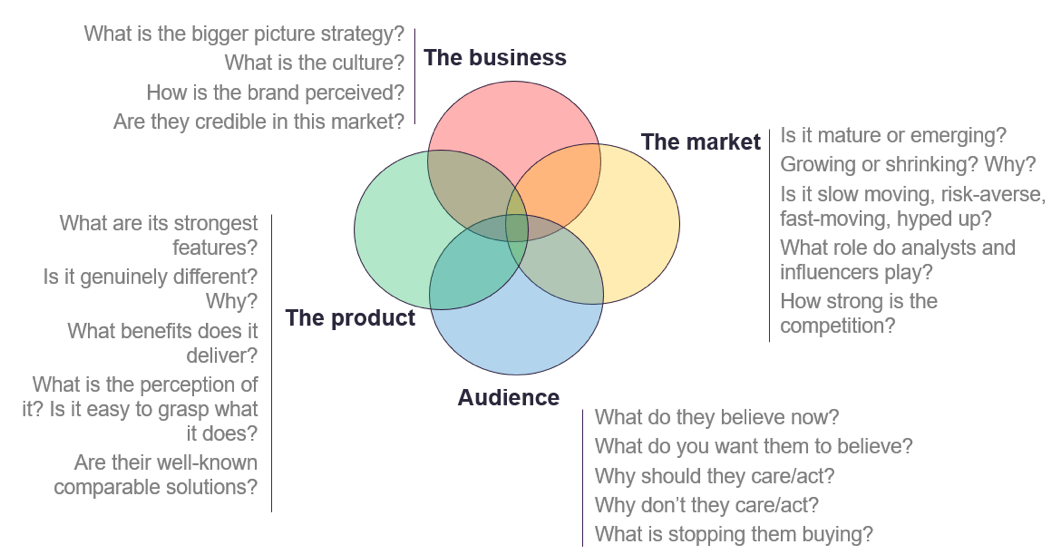How to develop a clear marketing brief that unlocks insight and gets to the heart of the marketing challenge
Our primary role as marketers is to constantly solve new and different types of challenges and demonstrate this insight through an effective marketing brief. From a client-side perspective, this may be responding to a change in the market, for example, a new competitor disrupting the status quo or a sudden change in consumer demand as a result of a new trend. From an agency perspective, this will often involve responding to a client request to help formulate a strategy for a new campaign or initiative, usually in support of the challenge they’re attempting to solve!
I’ve written about the importance of an effective marketing brief before and its positive impact on both clients and agencies. However, whilst a written brief is essential, one of the keys to the success of any good brief is defining and articulating the precise marketing challenge you’re trying to solve. Only once you have achieved absolute clarity on this key aspect can you then proceed onto the proceeding stages with confidence.
Within this post, we’re going to cover some of the main steps marketers should follow to define the true marketing challenge they’re looking to tackle. In the context of a client/ agency relationship, there’s some debate as to who ‘owns’ this part of the process. I believe the client has a responsibility to define the challenge to the best of their ability based on their intimate knowledge of the brand, market research, and product/ service. However many agencies will have a planning function to help develop an informed and measurable strategy on where to take a brand/business. For this post, I’m going to consider each of the steps from an agency’s perspective, although I intend that the guidance I offer can be applied by marketers of all stripes.
Download our Premium Resource – Digital marketing strategy guide
At last—a practical, actionable, step-by-step guide to creating a successful digital marketing strategy.
Access the Successful SEO guide
Step 1: Interrogate the problem
Start by evaluating where you are now and ultimately where you’re looking to get to. In other words, current state versus objective.
The strategy you will eventually develop can be seen as the bridge between these two elements and therefore a clear understanding of each is essential. This takes a lot of work from all sides involved and requires insight from key stakeholders from the client-side, including:
- Marketing
- Research/ insight
- Sales
- Finance
- Target audience/ customers
As this is just the beginning of the process the following questions can be helpful to start building an initial picture of what you’re dealing with:
Goals and objectives
- Strategic goals - what are the overarching business, sales, and marketing objectives?
- Targets - what does success look like in terms of the size of the opportunity, market share, brand awareness, or lead generation?
- Timings - over what period should objectives, goals, and targets be achieved?
- Budget - what is the budget we’re working to? Is there scope to expand and build over time?
Proposition and key messages
- Overarching brand positioning - what is the overall brand positioning and how is this factored into/ influencing the product/ service messaging?
- Key messages - what are the key benefits of the audience?
- 140-character summary - if you had to summarise the sales pitch in a tweet what would it be?
- Proof points - what are the tangible pieces of evidence, e.g. stats, case studies, success stories to prove the benefits of the product/ service?
- Calls to action - what can we offer our contacts as a next step that will be valuable to them?
Target audience
- Insight - what do we know about the audience and their challenges? Is there any research? What personas do we have to help bring the target to life?
- Decision-making - what triggers our target’s decision-making process? Are there certain micro-moments we should consider? From a B2B perspective, who are the decision-makers and who their influencers?
- Job roles (B2B) - what functions, job roles, areas of responsibility are we targeting?
Step 2: Discover a unique insight
The intelligence collected in the first step is extremely valuable but without organizing this in a way that can be effectively distilled into meaningful categories, you may find yourself drowning in information. The objective at this stage is to deep-dive into this information and look for a compelling insight:
“Insights are unspoken human truths, truths the subconscious recognises when it sees them. Often, insights are the arsenal of comedians and poets. A lot of creatives look up jokes about particular issues as inspiration for their ideas for this reason.
One of the best ways to find them? Start with something that seems obvious and keep asking ‘Why?’ and ‘What if?’” - Mark Pollard, Lead Strategist at The Mighty Jungle
Four main areas make up a marketing problem, which either on their own or in combination with one another, can be the source of a potential insight:

- The business - the objectives, strategy, and brand are all important as they underpin everything the business is trying to do. For example, if the business is aiming to move into a new sector, there must be good alignment across all of these elements
- The product - the product or service being sold and the unique aspects that differentiate from the competition
- The market - the maturity, competitiveness, and pace of the market all play a role in determining what path may or may not be realistic to pursue
- The audience - how your customers think and feel about the brand and position in the market can lead to some of the most unique and interesting insights
Some examples of really unique insights that underpinned some very successful brand campaigns include:
- Spotify: 2018 Goals - Spotify imagined what it’s audience might do in 2018 based on what happened in 2017. The campaign insight was anchored around the success of their famous 2016 campaign that proved that analyzing listener habits to identify specific insights enabled them to tell compelling stories.

- Always: #LikeAGirl - the Always campaign is one of the best-known campaigns from the last five years and it was driven by the insight that nearly 50% in their early teen years feel trapped by the fear of failure and as a result do not feel they can try new things. This enabled Always to build a movement aimed at empowering girls to take on challenges #LikeAGirl.
Step 3: Identify the roadblocks to success
The heart of defining the marketing challenge hinges on the identification of the obstacles preventing a business from achieving their commercial objectives:

The previous step told us where to look for insight. This stage is about how we can go about finding the insight and gain a sound understanding of the root cause behind the marketing challenge.
Whilst facts related to the business, market, and/ or product/ service are all extremely valuable, there’s often an audience-centric element at the core of the challenge. This requires us to consider what we need the target audience to think or do differently what may be preventing that desired change in behavior from happening. We need to be able to complete the following:
The customer currently ____ but we need them to ____. They currently won’t / can’t because ______.
So how do we get to the bottom of this puzzle and identify the marketing challenge? Through a combination of curiosity, precise questioning, and perseverance. Ask ‘why’ and keep going until you reach a satisfactory answer. For example: “Why are we behind our monthly sales target?”:
- Why? “Because our social campaigns are not resonating with the audience”
- Why? “Because very few people are engaging (commenting, liking, sharing) with the content
- Why? “Because the product is not relevant to them”
- Why? “Because the proposition is unclear”
- Why? “Because we don’t have a clear understanding of who we’re targeting and why our product is relevant”
Through a series of simple ‘why’ questions, we have found a potential source for the overarching problem that was originally identified.
Step 4: Develop a strategy
As soon as you are clear on the marketing challenge you’ll be in a position to start developing the strategy. The key components of a good strategy will include:
- Clearly defined objectives - demonstrate how overall business objectives (e.g. increase sales by 25% year-on-year) relate to marketing objectives (e.g. grow awareness by 50% within the next 12 months)
- A summary of where we are now - an overview of insight about the business’s product/ service, market and audience
- The marketing challenge - the obstacle between where we are now and where we want to be (i.e. achieving our objectives)
- Strategy statement - a concise strategy statement summarises your proposition and creative idea and how you will tackle the marketing challenge
- The proposition or core strategic idea - a much more detailed outline of how the strategy will be executed
- Risks/ threats - the potential stumbling blocks - internal and external - to executing the strategy and achieving objectives
Digital strategy in a time of crisis
Discover more blogs and ways to kickstart your organization's digital transformation strategy with actionable, practical online learning that gets results, fast!
See More
Step 5: Articulate the communication task
The final stage in the process is to put all this work together as part of a clear, concise brief. This involves a distillation of all the elements we’ve reviewed so far and the GET – (WHO) - TO - BY format is a very effective way of summarising the communication task:
GET - the primary audience (a person or cohort) plus your insight
Get ABC1 25-45 multi-taskers in the UK
WHO – an attitudinal expression/ insight into current behavior (this part may not always be required)
Who are looking for a convenient way to snack more healthily without compromising on taste
TO - the belief or behavior we want to re-frame
To discover and try our innovative new healthy snack that gives them the perfect way to snack on the go
BY - a summary of how the campaign Big Idea provides an opportunity to reframe behavior, encouraging the target audience to act/ respond differently
By showing them that our innovative new health snack is as tasty is traditional snacks but is lower in sugar, fat and saturates
With a strong, effective Get – (Who) - To - By you will be able to clearly articulate the communication task and summarise the marketing challenge for everyone involved in the campaign. This helps ensure everyone is aligned to the task at hand and you can progress to the campaign execution stage with confidence.
Conclusion to achieve a compelling marketing brief
The ability to identify and define the marketing challenge allows marketers from all sides to solve problems and produce great work. Without a clear view of where you’re trying to go, it becomes very difficult to get everyone on board and aligned to a set of agreed objectives.
Unfortunately defining the marketing challenge is not a quick or easy process and it takes time and due diligence. And whilst there is no definitive ‘right’ or ‘wrong’ way, the process outlined within this post will hopefully allow you to seek out and identify an insight that might explain why a problem is occurring and give you the opportunity to develop a winning campaign strategy.











